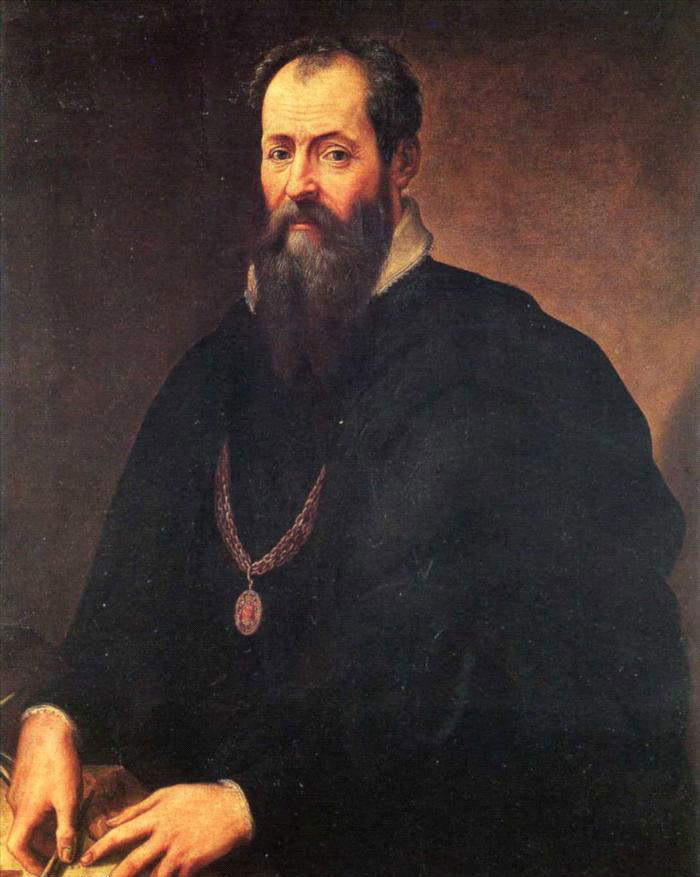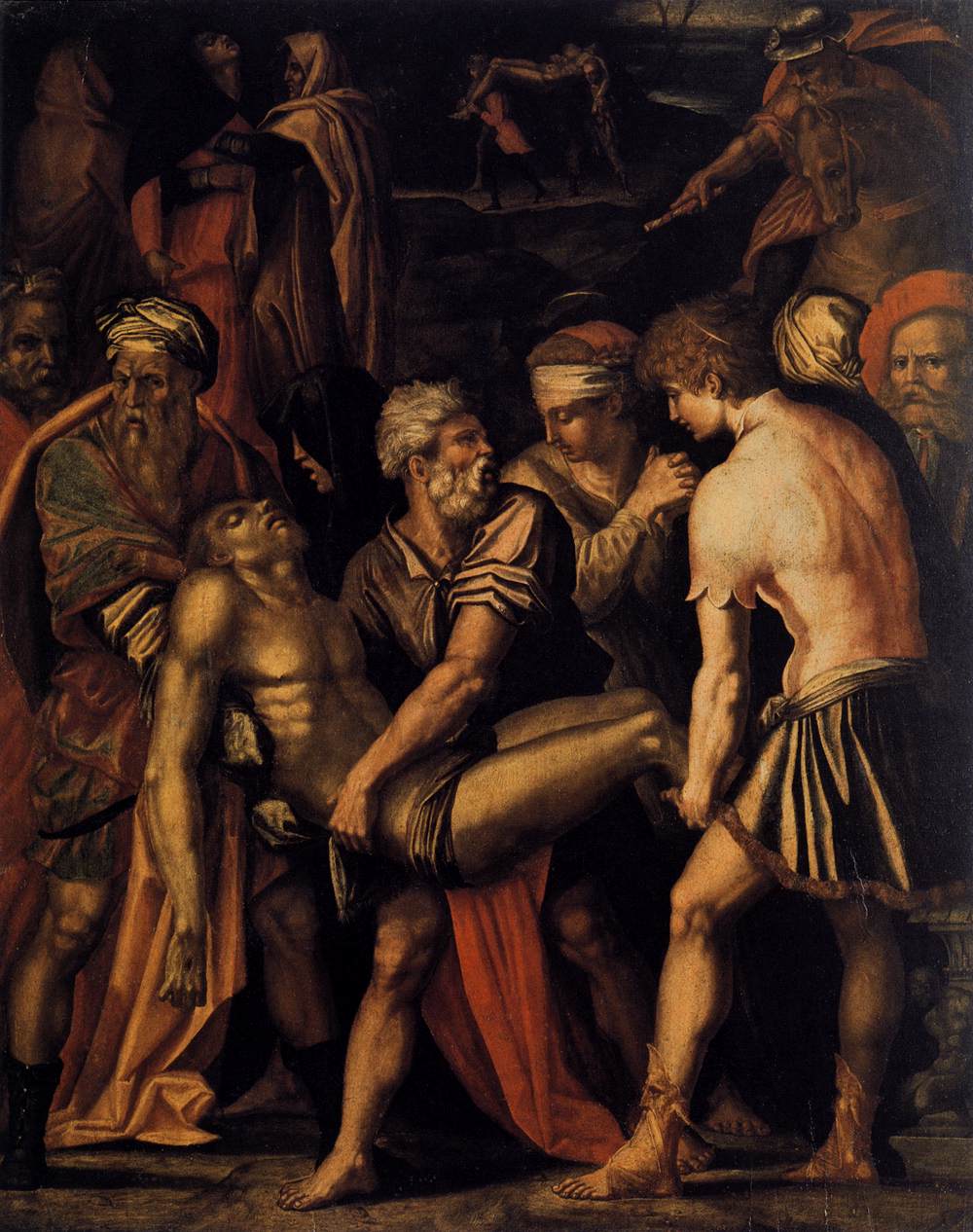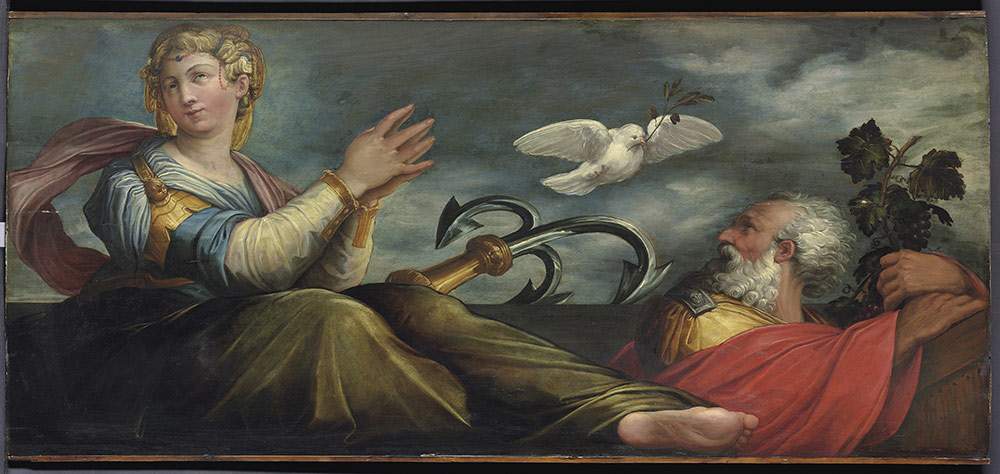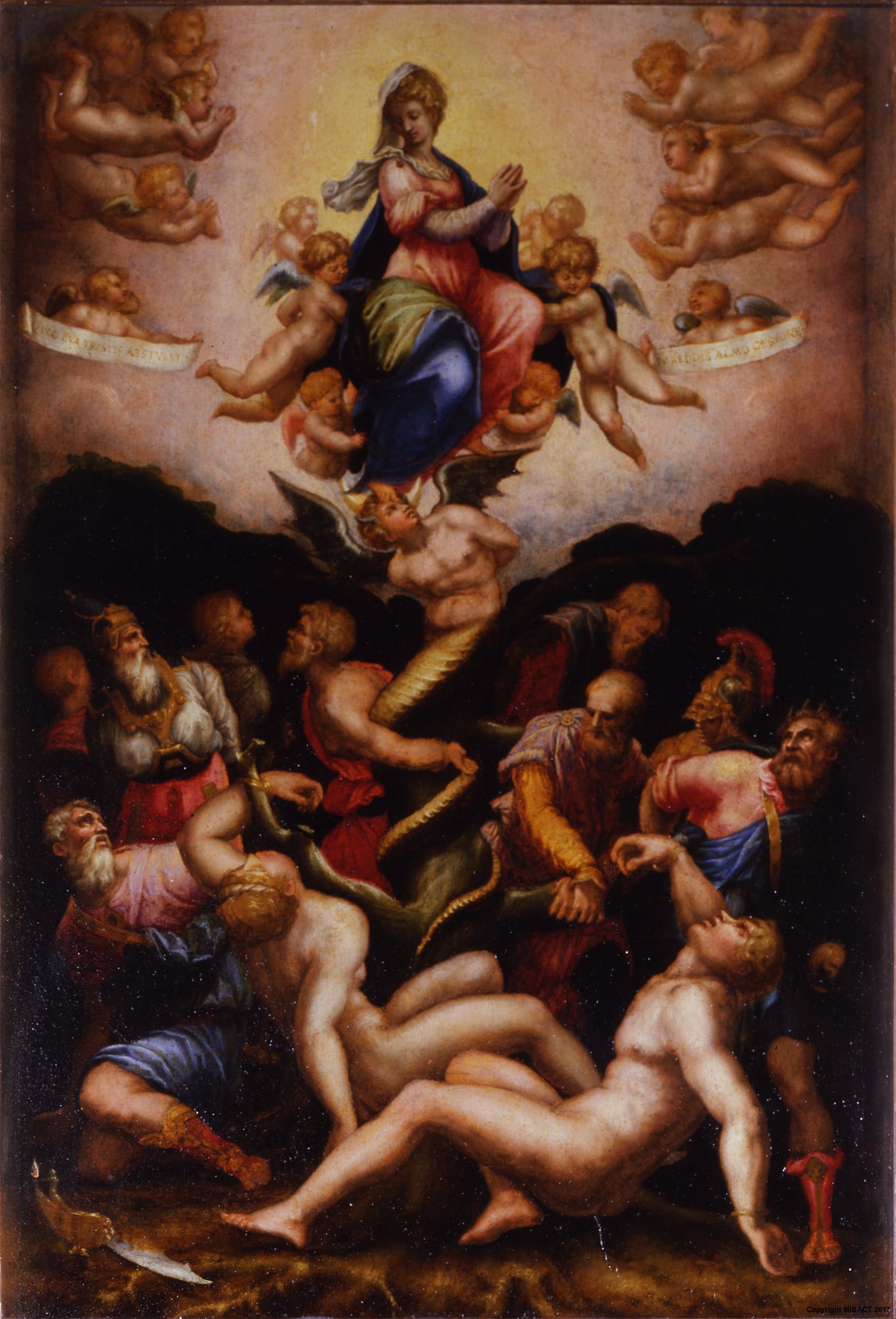Those who study art history will surely encounter him sooner or later: Giorgio Vasari (Arezzo, 1511 - Florence, 1574), as the author of Lives, a treatise that collects the biographies of many important artists from the Middle Ages to the time of the artist from Arezzo, and thus up to the early sixteenth century, is an indispensable source for studying art history from the thirteenth to the sixteenth century. However, Vasari was a multifaceted genius: he was not only an important writer on art, but also an architect (the building of the Uffizi in Florence is due to him) as well as one of the greatest and most prolific painters of his time.
Vasari was one of the most in-demand artists of his time, at a time when rivalries were the order of the day, and in the second edition of his Lives (of 1568), in which much space is reserved for contemporary artists, the Aretine does not hesitate to reserve very harsh words for his colleagues: for example, of Baccio Bandinelli, one of Giorgio Vasari’s bitterest rivals, he had to write that he was “very vile of words,” that “always saying evil and blaming the things of others was a cause that no one could suffer him,” that he “quarreled about everything gladly.” On Benvenuto Cellini, while appreciating several of his works, Vasari made a very subtle discrediting operation: Cellini was a great admirer of Michelangelo Buonarroti (in his autobiography he calls him the “divinissimo Micheagnolo,” and claims to have always studied his manner, without ever having deviated from it), and Vasari, in his Lives, never compares Cellini with Michelangelo, since, for Vasari, Cellini would not have been worthy of comparison with Michelangelo. Relations between the two after all were very strained, Cellini for example in one of his lyrics apostrophizing Vasari by calling him an “impious botolo.” Vasari also had several friends, however, including Bartolomeo Ammannati, Bastiano da Sangallo, and Benvenuto Garofalo, and he was also a longtime court artist with the Medici.
A great architect and Mannerist painter of no less importance, Vasari also helped to spread the Tuscan manner in the Veneto, providing cues to great Venetian artists (Tintoretto above all). Vasari then had a workshop in which relevant artists such as Giovanni Stradano (Italianized name of Flemish painter Jan van der Straet), Jacopo Zucchi, and Francesco Morandini known as Poppi were trained. All in all, a great protagonist of 16th-century Tuscany.
 |
| Jacopo Zucchi (attributed), Portrait of Giorgio Vasari (1571-1574; oil on panel, 100.5 x 80 cm; Florence, Uffizi Gallery) |
Giorgio Vasari was born in Arezzo on July 30, 1511. He trained in his hometown, studying with Guillaume de Marcillat, a French artist active in Arezzo who specialized in making works in glass. In 1524 he moved, at a very young age, to Florence (on the advice of Cardinal Silvio Passerini of Cortona, guardian of Ippolito and Alessandro de’ Medici) where he studied with Andrea del Sarto. Shortly thereafter, in 1531, he and Francesco Salviati made a trip to Rome to study the works of classical antiquity. His first known work dates from 1532, the Burial of Christ preserved in Arezzo at Casa Vasari (his residence now converted into a museum, which can be visited), a painting commissioned by the Medici.
The artist was thus already well established in the Medici circle, so much so that in 1534, when he was only twenty-three years old, he painted the portrait of the Duke of Florence, Alessandro de’ Medici. In October 1540, the prominent banker Bindo Altoviti commissioned him to paint what is perhaps his best-known pictorial work, theImmaculate Conception, an autograph replica of which is preserved in the Uffizi in reduced size for private use (the work was, however, variously replicated because of its great fortune). In 1541, Vasari moved to Venice at the invitation of his friend and fellow citizen Pietro Aretino(read more about Pietro Aretino’s importance to the arts here). In Venice, in addition to making the sets for Pietro Aretino’s “Talanta,” Vasari executed the decorations of Palazzo Corner-Spinelli. In 1542, the artist returned to Arezzo where he began to fresco the rooms of his house: the work would be finished in 1548. Meanwhile, in 1546, he had moved to Rome to work for Cardinal Alessandro Farnese, for whom he executed the frescoes in the salon of the Palazzo della Cancelleria, with scenes celebrating the pontificate of Paul III Farnese. The salon is also known as the “hall of a hundred days” because Giorgio Vasari boasted that he had finished it precisely in a hundred days (the story goes that Michelangelo, upon learning that the hall had been frescoed in that amount of time, sarcastically replied, “it shows”).
In 1550, at the publisher Torrentini, Vasari published his first edition of Lives of the Most Excellent Painters, Sculptors and Architects, one of the fundamental texts in the entire history of art. The following year he was back in Rome where, until 1554, he worked with Bartolomeo Ammannati, his great friend as well as a contemporary, at Villa Giulia. And it was in 1554 that Vasari returned to Florence in the service of Cosimo I, who entrusted him with the construction of the Uffizi Palace, Giorgio Vasari’s great masterpiece in the field of architecture. The palace was to house administrative (hence the name) offices. Work would begin in 1560 and end in 1580 after Giorgio’s death. Meanwhile, in 1562 the artist began to execute the very famous, large cycle of frescoes in the Salone dei Cinquecento in Palazzo Vecchio, celebrating the exploits of Cosimo I de’ Medici, who would become Grand Duke of Tuscany in 1569. The work would be completed in 1565. In 1568, Vasari published, at the publisher Giunti, the second edition of Lives, expanding it with biographies of contemporary artists and his own autobiography. Between 1570 and 1572, he executed the Perseus and Andromeda for Francesco I de’ Medici, and in 1572 he was commissioned to do the frescoes to decorate the interior of Brunelleschi’s dome of the Duomo of Santa Maria del Fiore in Florence(read more about the history and importance of Brunelleschi’s dome here). However, due to his death two years later, Vasari was unable to complete the work, and the commission would then be taken over by Federico Zuccari. In fact, the artist died in Florence on June 27, 1574.
 |
| Giorgio Vasari, Deposition (1532; oil on panel, 144 x 113 cm; Arezzo, Casa Vasari) |
 |
| Giorgio Vasari, Portrait of Alessandro de’ Medici (1534; oil on panel, 157 x 114 cm; Florence, Uffizi Gallery) |
 |
| Giorgio Vasari, Immaculate Conception (1541; tempera on panel; Florence, Santi Apostoli). Ph. Francesco Bini |
 |
| Salone dei Cinquecento. Ph. Credit Targetti Sankey |
The earliest surviving work by Giorgio Vasari, is the Burial of Christ preserved in Casa Vasari in Arezzo, a work of 1532 commissioned by the Medici: Vasari himself in his vita describes it as “a dead Christ carried by Niccodemo Gioseffo and others to the burial and behind the weeping Marys.” The work is important because it gives the viewer a clear idea of which was the main painter the 21-year-old Giorgio Vasari was inspired by for the painting and in general by whom he was inspired during this period, namely Rosso Fiorentino (in particular, this painting owes a great deal to Rosso’s Deposition, which is in the church of San Lorenzo in Sansepolcro, Tuscany: Rosso’s work is from 1528 and Vasari takes up the setting). Rosso is also the inspiration for the Deposition in the church of Santissima Annunziata in Arezzo, and which scholars date to about 1536-37, where Vasari takes up the scheme of Rosso’s very famous Deposition preserved at the Pinacoteca Civica in Volterra, with the very tall cross in the center, the two ladders leaning very precariously on the arms of the cross, and the characters even more precariously climbing up to lay the body of Jesus. By contrast, his perhaps best-known work dates from 1541, theImmaculate Conception, begun in October 1540 on a commission from the Florentine banker Bindo Altoviti, who intended to reserve it for the family chapel in the church of the Santi Apostoli (a valuable autograph replica in reduced size, which was intended for private devotion, is now in the Uffizi). This is a complex allegory of the Immaculate Conception: the Madonna, in keeping with the usual iconographic tradition derived from a passage in the Apocalypse of St. John, is depicted together with the moon, and also has one foot above the head of the devil, as a sign of victory. The devil is depicted in the form of a being half-man and half-serpent, with wings, and is twisted around the tree of knowledge at the feet of which are represented the two first sinners, Adam and Eve, naked, and at the branches of the trees a series of kings and prophets, Abraham, Isaac, Moses, David, and so on, signifying that they all derive from the two first sinners. Stylistically, this is a fully Mannerist painting: the dynamism and vigor of some of the characters are Michelangelo-inspired, while the colorism and taste for contorted poses derive from a study of the works of Rosso Fiorentino.
Fundamental for Vasari was then the trip to Venice, where he was invited by his fellow citizen, the man of letters Pietro Aretino, as he was called upon to make the scenic arrangements for one of his plays, and by Vasari’s own admission it was an important opportunity for him to be able to see Titian’s works live. But that was not all: on the way, in fact, the artist stopped in Parma and Mantua, where he became acquainted with the works of Correggio and Giulio Romano, authors from whom Vasari drew further insights to enrich his manner. Vasari’s stay in Venice, where he arrived in December 1541, lasted less than a year, but it was enough for him to produce some important works, such as the decorations of Palazzo Corner-Spinelli, which adorned the ceiling of one of the rooms of the palace and are now scattered in various collections.In Venice, however, the allegories of Patience and Justice remain, which are in the Gallerie dell’Accademia, and to which the rediscovered allegory of Hope has recently been added.
Of great importance for understanding Giorgio Vasari’s artistic journey are the frescoes in the Palazzo Vecchio: in fact, the artist was commissioned to create paintings in the Quarters of the Elements, the Quarters of Leo X, the Salone dei Cinquecento, and the studiolo of Francesco I: the most important ones are the frescoes in the Salone dei Cinquecento, created between 1562 and 1565. The Salone owes its name to the Council of the Five Hundred, a political body similar to the Maggior Consiglio in Venice, which existed at the time of Savonarola: the Salone had been commissioned by Savonarola himself to accommodate the Council’s assemblies, after which, on the return of the Medici it was converted into a reception hall and a place for theatrical performances. Vasari decorated it with scenes of battles in which the Florentines defeated their enemies, particularly the Sienese and the Pisans. On the walls, the scenes depicted by Vasari thus narrate some important Medici exploits: the conquest of Siena, the conquest of Porto Ercole, the battle of Marciano della Chiana, the battle of San Vincenzo, the siege of Livorno, and the siege of Pisa. Moreover, the battles against Siena were very recent facts: the Republic of Siena finally surrendered to Florence in 1559. This is a very scenic apparatus indeed: these are wide-ranging, grandiose and celebratory frescoes, which constituted one of Giorgio Vasari’s most challenging undertakings. It is, moreover, an accomplished Mannerist work. It is a Mannerism that finds its roots in Michelangelo, Pontormo and Rosso Fiorentino: we see very crowded scenes, which in certain passages seem almost unnatural (the colors themselves appear anything but realistic: they are the evanescent colors typical of early Tuscan Mannerism), we find dynamism, a taste for strange poses, we find the vigor of Michelangelo’s figures, the very tight-fitting robes that reveal the characters’ muscles, also typical of Mannerism. It is, in short, the most theatrical and most scenic work Vasari produced.
In painting, Vasari proposes a very pompous Mannerism that takes as its model, on the one hand, the Michelangelesque vigor that returns in many of his works, and on the other hand the two first great Florentine Mannerists, Pontormo and Rosso Fiorentino, with whom he sometimes shares a taste for the bizarre, moreover taking up some of their compositional schemes and different solutions from the chromatic point of view. This is a style capable of reaching strongly rhetorical and magniloquent heights: the paintings seem almost like orations translated into painting (this occurs especially in the case of celebratory and publicly commissioned works), with scenographic solutions aimed almost at arousing awe. The taste for the extravagant is exemplified by another famous work, Perseus and Andromeda: a late painting, it was made between 1570 and 1572 on commission from Grand Duke Francesco I for his studiolo in the Palazzo Vecchio, where it still stands today. The work tells the myth of Perseus and Andromeda: according to the story, the sea god, Neptune, had wanted to punish Andromeda’s mother, who boasted of her daughter by claiming she was more beautiful than the Nereids, the sea nymphs. The vengeful god kidnapped Andromeda and tied her naked to a rock, where she was threatened by a sea monster: she would later be freed by the hero Perseus. This is a very peculiar painting because of the taste for the bizarre that is still evident in several details, the subtle eroticism that permeates the composition (we notice it especially in the figures of the two nymphs who are embracing each other on the left), and the care with which Vasari describes the details, which divert attention somewhat from the main episode.
 |
| Giorgio Vasari, Allegory of Hope (1542; oil on panel, 178.4 x 79.4 cm; Venice, Gallerie dell’Accademia) |
 |
| Giorgio Vasari, Immaculate Conception (1541; tempera on panel, 58 x 40 cm; Florence, Uffizi Gallery) |
 |
| Giorgio Vasari, Battle of Marciano della Chiana (1563-1565; fresco; Florence, Palazzo Vecchio, Salone dei Cinquecento) |
 |
| Giorgio Vasari, Perseus and Andromeda (1570-1572; oil on blackboard, 117 x 100 cm; Florence, Palazzo Vecchio) |
The Lives are one of the cornerstones of art historical literature. They were published in two editions, one in 1550 (at the publisher Torrentini, reason why the first edition is known as “torrentiniana”) and another, expanded, in 1568 (publisher Giunti, and edition therefore known as “giuntina”). The Lives is a fundamental work for several reasons: the first is that it systematically gathered together a collection of biographies of all those authors, from Cimabue down to his contemporaries, whom Vasari considered worthy (“most excellent,” to use the term he used), and this determined the critical fortune (or, conversely, the critical misfortune) of a great many authors. The Lives are also important because with his work Vasari partly contributed to the formation of a precise view of art history, according to which Cimabue and Giotto were the architects of the rebirth of the arts after the centuries of the decadence of ancient art, and according to which art reached its greatest fulfillment in Michelangelo Buonarroti (moreover, the only contemporary artist mentioned in the Torrentine edition).
Again, Vasari’s work is useful for finding references to lost works of art and thus for better reconstructing the artistic and stylistic path of a painter or sculptor. Moreover, the Lives is one of the texts at the basis of the concept of "mannerism,“ because it is Giorgio Vasari himself who speaks of ”maniera“ in reference to the style of artists. According to Vasari, the ”modern manner" was initiated by Leonardo da Vinci, and found its highest expression in Raphael Sanzio and Michelangelo. For Vasari, the “modern manner” is also called the “third manner,” to distinguish it from the “first” (that of Cimabue and Giotto), and from the second (which according to our current view coincides with the early Renaissance). And if the first manner was seen by Vasari as inferior to the second, the third in turn surpassed the second by setting itself as a model to be imitated.
Giorgio Vasari’s monumental Lives is still a valuable reference for studying art, despite its limitations: the author often makes mistakes, demonstrates a keen taste for anecdotes, and often recounts curious episodes about artists about whose veracity we cannot have any feedback. Again, Vasari often makes use of hyperbole, uses a very lively narrative just as lively is his expressiveness also from a linguistic point of view, often lingering in descriptions of marginal aspects related to the artists. Moreover, Vasari, is very biased since he considered the Tuscan school the best and saw Florence as the hegemonic center of the arts.
 |
| Giorgio Vasari: life, works, historiographical importance |
Warning: the translation into English of the original Italian article was created using automatic tools. We undertake to review all articles, but we do not guarantee the total absence of inaccuracies in the translation due to the program. You can find the original by clicking on the ITA button. If you find any mistake,please contact us.